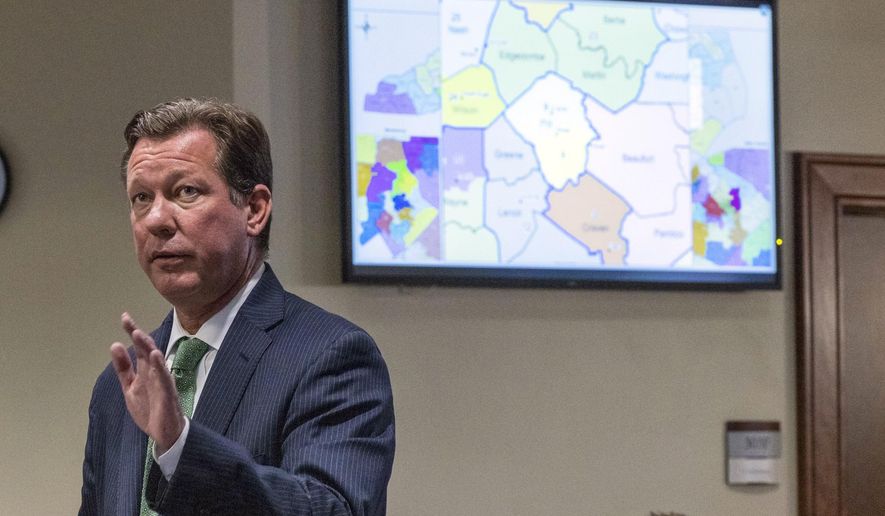RALEIGH, N.C. — A divided North Carolina Supreme Court struck down the state’s new maps for congressional and General Assembly seats Friday, declaring that state courts had authority to throw out lines engineered to secure a long-term Republican advantage in an otherwise closely divided state.
By a 4-3 decision - with the justices who are registered Democrats making up the majority - the state’s highest court directed the GOP-controlled legislature to redraw the plans by Feb. 18 and provide an explanation of how they calculated the partisan fairness of the new boundaries. Any replacement maps would still be used for the May 17 primaries.
The court’s decision reversed a ruling last month from a panel of three trial judges to let the maps stand, and declared partisan gerrymandering found in the redistricting approved by the legislature in November violated several provisions in the North Carolina Constitution. They include the right to free elections, freedom of speech and equal protections of citizens.
“When, on the basis of partisanship, the General Assembly enacts a districting plan that diminishes or dilutes a voter’s opportunity to aggregate with likeminded voters to elect a governing majority … the General Assembly unconstitutionally infringes upon that voter’s fundamental right to vote,” read the order of the court’s majority, signed by Associate Justice Robin Hudson.
The trial judges had found ample evidence that the legislature approved maps that were “a result of intentional, pro-Republican partisan redistricting.” But they declared it wasn’t the judiciary’s place to intervene in mapmaking - a duty left to the legislature - when partisan fairness in those plans was challenged. They called the redistricting process inherently political and said many of the lawsuits’ claims fall outside the scope of legal redress.
A majority on the Supreme Court disagreed, saying it’s the judiciary’s obligation to step in to block lines that skew a party’s control to the detriment of those with opposing viewpoints. Announced candidates for district seats may have to reconsider their decisions if boundary lines are redrawn.
Friday’s ruling is a major victory for state and national Democrats and their allies who had invested greatly in overturning the maps and thwarting Republican gains for the next decade. It could also make it harder for Republicans to retake control of the U.S. House this fall. A group associated with the National Democratic Redistricting Committee - led by former U.S. Attorney General Eric Holder - supported a bloc of voters who sued.
“This is the justice we sought when we filed this lawsuit,” said Carrie Clark, executive director of the North Carolina League of Conservation Voters, which was another plaintiff. “With new, constitutional maps, North Carolinians will have a fighting chance to elect a government that fulfills their desire for environmental justice and climate action.”
The lawsuits were bolstered by mathematicians and electoral researchers who presented evidence of their analysis of trillions of map simulations. They testified the new lines were likely to give the GOP 10 of the state’s 14 U.S. House seats as well as state House and Senate majorities in almost any political environment. Republicans currently hold an 8-5 seat advantage. The state gets a 14th seat because of population growth reported in the census.
The plaintiffs argued that the enacted maps thwarted the will of the people of North Carolina and the boundaries should produce political outcomes more in line with competitive statewide elections over the past decade. Some plaintiffs also alleged the mapmakers consolidated or fractured Black voters within districts, which reduced their ability to elect preferred candidates, resulting in illegal racial bias.
Republican legislators, who didn’t immediately comment on Friday’s ruling, wanted the trial judges’ ruling to stand, saying a state Supreme Court decision from the early 2000s said partisan advantage can be considered in mapmaking. They said the redistricting process was transparent and prohibited the use of racial and political data.
Friday’s majority order directed lawmakers to use election and population figures to determine whether racially polarized voting is sufficient in areas of the state to determine whether districts must be drawn that protect Black voting strength.
Chief Justice Paul Newby, a Republican writing a dissent, said the court’s majority “tosses judicial restraint aside, seizing the opportunity to advance its agenda” with a partisan bias.
“By choosing to hold that partisan gerrymandering violates the North Carolina Constitution and by devising its own remedies, there appears to be no limit to this court’s power,” Newby wrote. The court’s other two Republicans - Associate Justices Phil Berger Jr. and Tamara Barringer - joined with Newby.
Friday’s prevailing order warned the General Assembly that the court will pick its own maps if lawmakers don’t offer their own plans in time and welcomed the plaintiffs to submit possible remedial proposals.




Please read our comment policy before commenting.